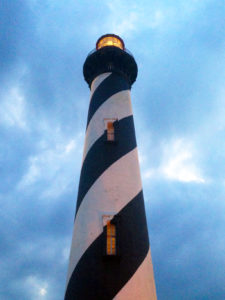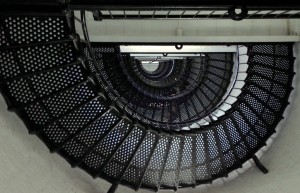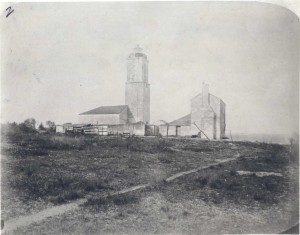Six Common Misconceptions about the St. Augustine Lighthouse
The St. Augustine Lighthouse & Maritime Museum is a popular destination in our nation’s oldest city, but many misconceptions about it persist. Each of the following are NOT TRUE, but are often thought to be.
Misconception #1 – The St. Augustine Lighthouse is Florida’s first lighthouse.
Florida’s first lighthouse was the old St. Augustine Lighthouse (often called the Old Spanish Watchtower). It was a refurbished Spanish-built watchtower. The current lighthouse replaced the old one when beach erosion began to threaten the first lighthouse’s foundation. It eventually fell into the ocean in 1880.
The current lighthouse isn’t even particularly old for Florida lighthouses. It replaced the older tower in 1874, long after the construction of other Florida lighthouses like Amelia Island Light (1838), Cape Florida Light (1846), and Jupiter Inlet Light (1860) to name a few.
Misconception #2 – The St. Augustine Lighthouse is the tallest lighthouse in Florida.
The tallest lighthouse tower in Florida is the Ponce Inlet Light at 175 ft tall. The St. Augustine Lighthouse is 165 ft tall. Of course, height of the tower is not the only way to measure the height of a lighthouse. Sailors are more interested in how high the light is above sea level, also known as a lighthouse’s “focal plane”. The higher the focal plane, the farther away sailors can see the lighthouse.
A smaller lighthouse located on an elevation can have a higher focal plane than a taller lighthouse at a lower elevation. For example, the Pensacola lighthouse is 150 ft tall, shorter than the St. Augustine lighthouse by 15 ft. However, because it is located on high ground its focal plane is 191 ft, higher than the St. Augustine lighthouse by 30 ft.
Misconception #3 – The St. Augustine Lighthouse is not operational.
The St.  Augustine Lighthouse is, and has always been, an active aid-to-navigation. Sailors off St. Augustine’s coast use the lighthouse as a landmark to confirm their location. Even with the latest mapping technologies, mariners still use landmarks like lighthouses for navigation.
Augustine Lighthouse is, and has always been, an active aid-to-navigation. Sailors off St. Augustine’s coast use the lighthouse as a landmark to confirm their location. Even with the latest mapping technologies, mariners still use landmarks like lighthouses for navigation.
Of course, it is no longer lit by an oil lantern. Today a 1000-watt light bulb illuminates the lighthouse, with an electric motor to turn the large first-order Fresnel lens that sends our light out to the horizon. It even turns on and off like a streetlight, with a sensor detecting whether outside is light or dark.
Misconception #4 – The St. Augustine Lighthouse helps ships avoid dangerous obstacles.
Lighthouses serve two main purposes. The first is to stand as a navigational aid. The second is to alert mariners to obstacles they need to avoid. Other than the shoreline itself, the coastline along St. Augustine offers no obstacles a sailor would need a lighthouse to avoid. Our lighthouse is primarily an aid-to-navigation, offering sailors a unique landmark during daytime and nighttime to help identify or confirm their location along the Atlantic coast.
Misconception #5 – The St. Augustine Lighthouse is a national or state park.
The lighthouse is on the National Register of Historic Places but it is not a national or state park. The St. Augustine Lighthouse & Maritime Museum is a private non-profit 501(c)3 organization that operates the lighthouse as part of its responsibilities. We took responsibility for the lighthouse under the National Historic Lighthouse Preservation Act of 2000.
As such, we are reliant on admissions and fundraising to support everything we do here including historic preservation on our historic structures, maritime archaeology, school programs, summer camps, and museum programs and exhibits, among others.
And finally, perhaps the most painful misconception…
Misconception # 6 – The St. Augustine Lighthouse has an elevator.
 The lighthouse observation deck is 140 feet above the ground and there is no elevator to get you there. Only 219 steps stand between you and the best view in town!
The lighthouse observation deck is 140 feet above the ground and there is no elevator to get you there. Only 219 steps stand between you and the best view in town!
Paul Zielinski is Director of Interpretation for the St. Augustine Lighthouse & Museum. He received his master’s degree in Public History from the University of West Florida and joined the lighthouse family in 2011.


